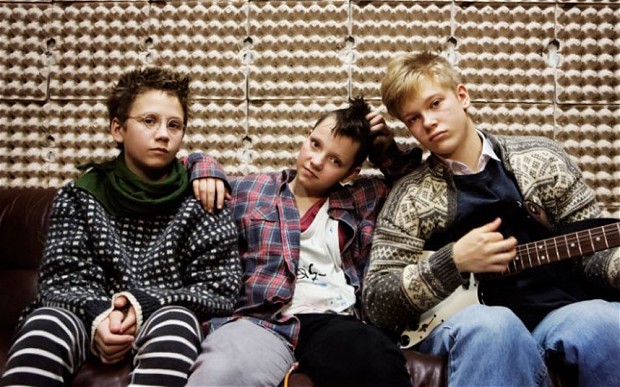Three girls start a band in We are the Best!, but that’s not really what the movie is about. Set in Stockholm in 1982, most of the action does indeed focus on punk-music-obsessed pre-teens engaging in indiscriminate cymbal-slamming and bass-strumming – yet there are points of much greater interest here. Director Lukas Moodysson isn’t very interested in the music itself. What he wants to find – what the movie actually is about – is the pissed-off fuck-everyone feelings of rebellion all kids feel in their bellies at some point. We are the Best! is about that spitfire energy that fuels punk art, in all its forms.
Moodysson doesn’t deserve all the credit for capturing that vitality, though, not the half of it. That belongs to the three girls who make up the eponymous band: Mira Barkhammer as Bobo, team wallflower; Mira Grosin as Klara, whose mohawk and lie-cheat-steal attitude render her the gang’s radical; and Liv LeMoyne as Hedvig, a church-girl-turned-riot-girl who’s plugged her guitar in after 4 years of playing acoustic. There’s not a single broad note in any of their scenes. They easily outclass the adults who surround them, even. (During a drunk scene, they’re so convincingly sloppy you can’t help but suspect that Moodysson was slipping them sips of real booze off-camera.) The setup here (and the title) may scream “quirky!” or “girl power!”, but these three performances provide naturalistic, lived-in specificity that transcends such played-out adjectives and bumper-sticker platitudes. We are the Best! is hardly the best, but these girls just might be.
One day, Klara and Bobo start banging on instruments as a way of rebelling at the youth center. On another, they recruit Hedvig and start learning how to actually play. The three end up following the same path most creative kids follow when they begin to feel passionate about creating art: First, they’re invigorated by the prospect of success (“the prettiest girls in town!,” they chant, during their first jam session). Then, they’re daunted by the prospect of spending years honing their craft (Klara freaks when she realizes it took Hedvig 4 years to become halfway proficient on the guitar). After that comes crises of confidence, represented here by a quick subplot where a boy comes between the three, temporarily shutting the band down. Lastly, eventually, they realize – as most do – that playing bad music while they develop is a more attractive prospect than playing no music at all.
Some things happen in the interim, not so dramatically. The aforementioned boy comes and goes, there’s a little bit of conflict over an incident of peer-pressured hair-cutting, as well as some cut-ups regarding a performance that doesn’t go well, but that’s about it. Nothing feels exaggerated, or amped-up, by Moodysson’s script (adapted from as-yet-untranslated comics drawn by his wife) or by his eye. Striking images occur – the girls defiantly flicking off their own audience while playing to a chorus of boos; a moment where one of the girls is left alone, romantically spurned, on a snow-covered roof; or one in which Hedvig first catches a glimpse of her short-haired self in the mirror – but they come and go without much exaltation. It’s kind of like real life.
Moa Li Lemhagen Schalin’s ragged, never-glamorous costume design does much to cultivate the film’s lived-in-ness and immediacy, as does the intentionally drab production design by Paola Holmer and Linda Janson. But, looking back to similar qualities in Fucking Amal and Together, it’s clear that at least a fair bit of the credit belongs to Moodysson. Those two films, along with this latest one, are presented with the visual grammar of home movies: his camera stands in the corner of rooms, whipping, panning, and zooming to capture whatever’s of interest at a given moment. He starts off with locked-down, meticulously composed establishing shots (one that sees the girls flirting with their young paramours, behind the cover of snow-swept tree branches, is a stunner,) and then cuts in with restless, tumbling vigor, as if breaking the illusions of beauty provided by life’s idyllic imagery. Most period films are about the remove between the audience and the era depicted, but Moodysson shoots to remove the remove.
He probably could have done just as well with long shots and static cameras, but his shakier aesthetic matches the not-quite-mature punk affectations of the girls well. They’re still figuring out how they feel about politics and music and everything else, and the camera simply tries to keep up. After all, these girls aren’t rebelling against anything specific, they’re just acting on the primal urges of youth, those feelings that tell us to tear down everything that came before we did. (The lyrics of their most commonly performed song are “Hate the ______!” with everything from “sports” to the names of neighboring towns filling in the blank.) We could try and attach their rebellion to a specific cultural, sociopolitical, or gender-related movement, but that’d be missing the point – their disenfranchised rage is universal, a constant of the human experience. Like a famous character once said, when asked about what he was rebelling against: “Whaddya got?”
We are the Best! is hard to dislike, being a well-made, deeply felt, bracingly immediate film about the rebellious spirit of youth, something that pretty much everyone on the planet can relate to. It has music, spunk, triumph, feminist thought, a recognizable soundtrack, and a gaggle of other things that are going to hit various pleasure centers on the brains of those who watch it. So while there doesn’t seem to be much here beyond a bildungsromen that pleasurably depicts a specific point in time, maybe there doesn’t need to be. Put it this way: this latest Lukas Moodysson movie may not be essential cinema, but no movie-lover should pass on seeing it, either.





















